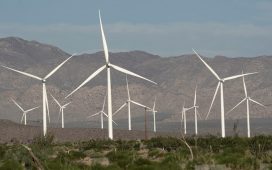With help from Zack Colman, Annie Snider, Eric Wolff and Ben Lefebvre
Editor’s Note: Morning Energy is a free version of POLITICO Pro Energy’s morning newsletter, which is delivered to our subscribers each morning at 6 a.m. The POLITICO Pro platform combines the news you need with tools you can use to take action on the day’s biggest stories. Act on the news with POLITICO Pro.
— U.S. greenhouse gas emissions tumbled 18 percent this spring as a result of the coronavirus pandemic that crippled the economy, according to a new analysis released today.
— Joe Biden’s presidential campaign released the policy recommendations reached by its joint task force with supporters of Sen. Bernie Sanders, which called in part for eliminating carbon pollution from power plants by 2035.
— A spokeswoman for Energy Transfer says it has not yet begun to shut down the Dakota Access Pipeline in North Dakota as a federal judge had ordered Monday.
HAPPY THURSDAY! I’m your host, Kelsey Tamborrino. The American Chemistry Council’s Andrew Fasoli gets the trivia win for correctly identifying Helen Eugenie Moore Anderson, the first woman to hold the rank of U.S. ambassador. Anderson served under President Harry Truman in 1949 as ambassador to Denmark. For today: Who was the first person ever to receive a lifetime pass to any Major League Baseball game, but never used it? Send your tips, energy gossip and comments to [email protected].
Check out the POLITICO Energy podcast — all the energy and environmental politics and policy news you need to start your day, in just five minutes. Listen and subscribe for free at politico.com/energy-podcast. On today’s episode: How much is Covid-19 lowering emissions?
STUDY: GHG CUTS COME WITH HIGH COST: U.S. greenhouse gas emissions dropped 18 percent from March 15 to June 15 because of the coronavirus pandemic, according to researchers at Rhodium Group. Researchers also found that U.S. emissions of carbon dioxide and other heat-trapping gases could see a lower growth trajectory through the end of the decade because of the health crisis, Pro’s Zack Colman reports this morning.
The analysis found greenhouse gas emissions will likely be 6 to 12 percent below pre-Covid-19 projections through the end of the year, amounting to “the largest annual drop in GHG emissions in recorded history.” Through 2030, emissions could fall between 2 to 12 percent relative to the pre-pandemic baseline.
But those declines come at huge economic cost, Rhodium said. “The emission reductions associated with our scenarios, while sizeable, are certainly no cause for cheer. The economic damage and human suffering of COVID-19 has already been substantial and will likely continue for some time,” the report said.
Rhodium noted the high economic costs associated with the spring reduction in emissions, which it estimated at between $3,200 and $5,400 in lost economic activity per ton of reduced carbon dioxide depending on the speed of the nation’s economic recovery. That compares to about $11 to reduce each ton of CO2 under the Obama administration’s regulations for coal-fired power plants that were withdrawn by the Trump EPA.
TASK FORCE PUSHES AMBITIOUS CLIMATE PLAN: Members of the “unity” task force formed by former Vice President Joe Biden and Sen. Bernie Sanders (I-Vt.) called for eliminating carbon pollution from power plants by 2035, strengthening U.S. efforts on a host of international climate change initiatives and putting environmental justice at the crux of a potential Biden administration’s policies, Pro’s Anthony Adragna reports.
The Biden campaign on Wednesday released the task force’s recommendations, which include a raft of other progressive policies. Co-chaired by former Secretary of State John Kerry and Rep. Alexandria Ocasio-Cortez (D-N.Y.), the task force recommends eliminating carbon emissions from the power sector in the next 15 years with “technology-neutral standards for clean energy and energy efficiency,” as well as the installation of 500 million solar panels and 60,000 onshore and offshore wind turbines. It calls for all new buildings by 2030 to have net-zero emissions and immediately strengthen car and truck emissions standards.
The emphasis on climate change — it appears on the first page of the 110-page document — further suggests Biden would push aggressively to tackle the problem as one of his top priorities in office. Varshini Prakash, who served on the task force and is co-founder of the Sunrise Movement, hailed the platform as a sign that Democratic leaders were listening to young people around the country clamoring for immediate action to stave off the worst impacts of climate change.
Ocasio-Cortez tweeted that the task force “accomplished a great deal.” Among the notable gains, she said, “we shaved *15 years* off Biden’s previous target for 100% clean energy.” The recommendations will be weighed by the Democratic National Committee’s Platform Committee, as well as Biden.
By the way: Biden is in Pennsylvania today to deliver remarks on his economic recovery plan. Bloomberg reports that the plan will draw on a proposal by Sen. Elizabeth Warren (D-Mass.) to use “the federal procurement process to buy American-made clean energy for government use and export.”
DAPL STILL PUMPING OIL: The operator of the Dakota Access Pipeline is making no moves yet to shutdown the North Dakota pipeline, despite an order from a federal judge on Monday to empty it of oil by Aug. 5, a process that Energy Transfer said could take roughly 90 days. Company spokeswoman Vicki Granado tells ME that, “We have not yet started the process of shutting it down as we work through the legal process.”
The company said Wednesday that D.C. District Court Judge James Boasberg had “exceeded his authority in ordering the shutdown of the Dakota Access Pipeline” until the Army Corps of Engineers conducted an environmental review of a section of the pipeline, and filed a motion asking that the shutdown order be suspended while it appeals the court ruling.
“The broad economic and environmental consequences for third parties, including the numerous states that strongly support continued operation of the pipeline, coupled with the irreparable loss of revenue to Dakota Access and its affiliates, far exceed any possible risk — much less any conceivable harm — to the Tribes from a stay,” the company said in its latest motion, noting that the economic impact comes as the country is reeling from the coronavirus pandemic and associated economic downturn. Energy Transfer asked Boasberg, who already rejected the company’s bid for an emergency stay, to rule by July 14 on its request to put the decision on hold while it pursues an appeal.
ENVIROS ASK COURT TO HOLD FIRM ON TOLLING ORDERS: The Allegheny Defense Fund on Wednesday asked the court to deny FERC’s request for an extra 90 days before the court’s ruling from last week takes effect. FERC asked on Monday for an extra 90 days to use “tolling orders” to delay making decisions on rehearings. Without rehearing decisions, participants in a case can’t take the agency to court. The court ruled the orders illegal last month.
BUT WHAT’S THE RISK? Communities from Georgia to Illinois have expressed outrage over their elevated cancer risk stemming from emissions of a toxic gas from neighboring medical sterilizing facilities, and EPA has responded by promising to update the air regulation governing the facilities (Reg. 2060-AU37). But a spate of Senate Democrats are worried that EPA may not take a close look at those cancer risks as part of its review of the quarter-century-old regulation.
In a letter to EPA Administrator Andrew Wheeler from Sen. Tammy Duckworth (D-Ill.) and 10 colleagues, the lawmakers urged EPA to conduct a risk review as part of the regulatory update, pointing to the fact that EPA scientists in 2016 concluded that the chemical ethylene oxide is dangerous at far lower levels than previously thought. The letter comes after a federal judge ruled late last month that EPA has to review residual health risks only once per rule under the Clean Air Act — a review that was completed for sterilizers in 2006 using the agency’s obsolete view of ethylene oxide’s risks. After that, the judge said, EPA is required to consider only whether new technologies are available for capturing emissions, though the agency can choose to study residual health risks if it wants.
“If the agency limits itself to only assessing achievable technology and does not assess any residual risk that cannot be reduced through control technology, risks to public health, including an elevated risk of cancer, may remain after the identified technologies are implemented,” the Democratic lawmakers told Wheeler, asking that he tell them by July 17 whether the agency plans to conduct a risk review as part of the rule update.
BROUILLETTE’S TRIP TO TEXAS: Energy Secretary Dan Brouillette is back home in San Antonio today, where he’ll meet with regional energy leaders to discuss the current state of energy markets. Earlier this week, the Texas Railroad Commission said it issued a total of 312 drilling permits in June, compared with 1,001 in June 2019.
Brouillette is also expected to virtually join global energy ministers this morning for the International Energy Agency’s Clean Energy Transitions Summit, where he will provide remarks on “the United States’ effective competitive energy approach” and its effect on the U.S. economy and carbon emissions, DOE said. IEA Executive Director Fatih Birol told reporters Monday there won’t be a joint communiqué, but there may be a policy document to “lay out common denominators” between the countries — which represent 80 percent of global energy use and emissions — in order to create “badly needed” momentum to foster the clean energy transition. Livestream.
STATES TAKE ACTION ON RGGI: Virginia Gov. Ralph Northam announced on Wednesday that the commonwealth had officially joined the Regional Greenhouse Gas Initiative, a regional carbon cap-and-trade program. In doing so, Virginia became the first Southern state to join the program. According to the governor’s office, about 45 percent of the proceeds from the program will go to community flood prevention and coastal resilience programs, and another 3 percent will be used to further statewide climate planning efforts.
— Also on Wednesday, Pennsylvania’s GOP-controlled House passed legislation that would block Gov. Tom Wolf’s authority to control or limit carbon dioxide emissions, including any action to join RGGI, by requiring legislative approval to do so. The bill still requires approval by the state Senate, and Wolf’s office has already told The Associated Press he would veto the bill.
EXTREME HEAT, HUMIDITY DAYS DOUBLED: Climate change has contributed to the number of extremely hot, humid days more than doubling in most states and regions since 1980, according to an analysis by Climate Central. The researchers pulled data from 474 U.S. weather stations to calculate the change in frequency according to wet bulb temperatures, which gauge how heat, moisture and other conditions affect people. All states except a clutch of Southeastern and Appalachian states registered a more than 100 percent increase in the high heat and humidity days, which can present conditions fatal to humans. The analysis said the results carry “disproportionate impacts” for seniors, communities of color, military service members and agricultural workers.
ME FIRST — COALITION UNVEILS CLIMATE PROPOSAL: The SmarterSafer Coalition — a national coalition made up of environmental, taxpayer, insurance and housing groups focused historically on flood insurance reform — is out with a new climate policy proposal today. “With a changing climate, there is a lot of peril and with that peril comes a lot more exposure to taxpayer dollars,” Chris Brown, executive director at SmarterSafer Coalition, told ME. “We don’t just have to plan in the flood space anymore, we should be talking about wildfire and whether or not there are adaptation measures that can be taking place, or risk-transfer programs that can be put into effect that are good for the environment but also good for the federal bottom-line.”
Recommendations in the white paper include prioritizing pre-disaster mitigation efforts, reforming the National Flood Insurance Program to ensure that premiums reflect accurate levels of risk and to increase the role of the private sector, and utilizing insurance and catastrophe bonds to protect infrastructure. It also calls for codifying standards like a federal flood protection standard as a stipulation for infrastructure spending, promoting federal incentives for green housing and retrofitting projects, tying federal disaster spending to pre-disaster mitigation, expanding the use of natural barriers like marshes and dunes, and enhancing opportunities for public-private risk transfer. Members of the coalition include American Rivers, Natural Resources Defense Council, Center for Climate and Energy Solutions, R Street, and Taxpayers for Common Sense.
— Mike Stanton joined Sun Tribe Development, Sun Tribe’s utility-scale provider, as vice president of development and Austin deButts is joining as director of origination. Stanton is a Cypress Creek and NextEra alum and deButts joins from Sol Systems.
— “Dozens of Trump veterans cash out on K St. despite ‘drain the swamp’ vow,” via POLITICO.
— “EPA air official accused of conflict over payments via gas giant,” via Bloomberg Law.
— “Is this the end of pipelines?” via The New York Times.
— “Wyoming regulators approve state’s first new coal mine in decades,” via Casper Star-Tribune.
— “EU bets on clean hydrogen to decarbonize and boost economy,” via The Associated Press.
— “How America’s hottest city will survive climate change,” via The Washington Post.
THAT’S ALL FOR ME!








